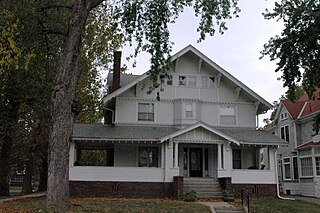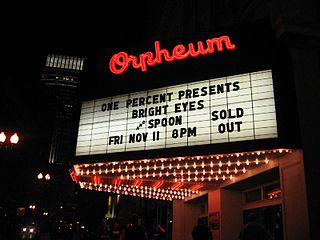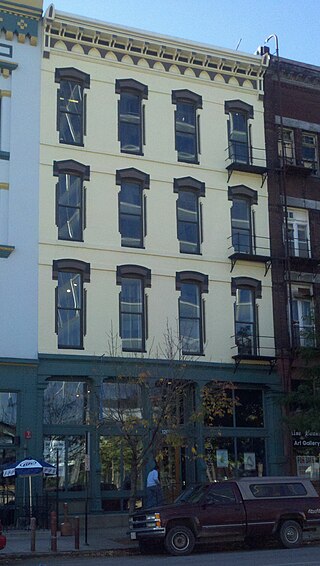Related Research Articles

Lee Oscar Lawrie was an American architectural sculptor and an important figure in the American sculpture scene preceding World War II. Over his long career of more than 300 commissions Lawrie's style evolved through Modern Gothic, to Beaux-Arts, Classicism, and, finally, into Moderne or Art Deco.

William LaBarthe Steele was an American architect from Chicago, Illinois. He is considered a principal member of the Prairie School Architectural Movement during the early 20th century.
Architecture in Omaha, Nebraska, represents a range of cultural influences and social changes occurring from the late 19th century to present.

The Charles Storz House is located at 1901 Wirt Street in the Kountze Place neighborhood of North Omaha, Nebraska. The Arts and Crafts style house was designed by the Omaha architectural firm of Fisher and Lawrie and built in 1909. In 1983 it was renovated as a historic preservation project involving the National Trust for Historic Preservation, Landmarks, Inc., the City of Omaha and the Consumer Services Organization. In 1984 it was designated an Omaha Landmark.

The Christian Specht Building is located at 1110 Douglas Street in downtown Omaha, Nebraska. It is the only existing building with a cast-iron facade known in Nebraska today, and one of the few ever built in the state. The building was deemed an Omaha landmark in 1981, and was listed on the National Register of Historic Places in 1977.

Mason School is located at 1012 South 24th Street in south Omaha, Nebraska, United States. Designed in the Richardson Romanesque style by the architectural firm of Mendelssohn, Fisher and Lawrie, the school was built in 1888 by the brick manufacturing and construction firm of Hadden, Rocheford & Gould. The school closed in the late 1970s and was converted into apartments. It was designated an Omaha Landmark in 1986 and listed on the National Register of Historic Places that same year.

The Bemis Bag Company Building is a historic building located in downtown Omaha, Nebraska. Built in 1887 in a commercial style, the building was designed by the prolific Omaha architecture firm of Mendelssohn and Lawrie. It was designated an Omaha Landmark on September 12, 1978, and was added to the National Register of Historic Places on January 11, 1985. In addition to its own listing on the NRHP, the Building is also included in the Warehouses in Omaha Multiple Property Submission.

The Orpheum Theater is a theater located in Omaha, Nebraska. The theater hosts programs best served by a more theatrical setting, including the Omaha Performing Arts Broadway Season, presented with Broadway Across America, and Opera Omaha's season. The theatre is listed on the National Register of Historic Places. The main auditorium is a proscenium theater known as "Slosburg Hall". The theater has a theatre organ, made by Wurlitzer.
John Latenser Sr. (1858–1936) was an American architect whose influential public works in Omaha, Nebraska, numbered in the dozens. His original name was Johann Laternser.

The Broatch Building is located at 1209 Harney Street in Downtown Omaha, Nebraska. Built in 1880 with an 1887 expansion, it was designated an Omaha Landmark on December 20, 1983, and is a contributing building to the Old Market Historic District, which was listed on the National Register of Historic Places in 1981.

The G. C. Moses Block is a row of several historic buildings located at 1234-1244 South 13th Street in Downtown Omaha, Nebraska. The two-story building was completed in 1887 by Mendelssohn & Lawrie and Simonds & Linesay, in the Late Victorian style of architecture.
Hicks Terrace is located at 3005-3011 Pacific Street and 1102 South 30th Avenue in Omaha, Nebraska. Built in 1890, the structure represents the Queen Anne style of architecture. Designed by the early Omaha firm of Mendelssohn, Fisher and Lawrie, the building was constructed in 1890, and designated an Omaha Landmark on April 21, 1981. It was built as one of the multi-family residential structures in Omaha to be made of masonry. It was specifically designed to cater to the elaborate trolley networks that opened many new areas of the city to development.

The Minne Lusa Pumping Station was located along John J. Pershing Drive in the Florence neighborhood of North Omaha, Nebraska. The station, which was surrounded by settling basins, was the main source for pumping, filtering, and distributing Missouri River water throughout the City of Omaha. The station was the namesake of the Minne Lusa neighborhood located immediately to the south.

George Anthony Berlinghof was a German-born architect who designed a number of important buildings in Lincoln and other cities in Nebraska. Some of his surviving works are listed on the National Register of Historic Places.

William F. Gernandt was a German-born architect who was based in Nebraska. He designed a number of courthouses and other buildings that are listed on the National Register of Historic Places.
Rocheford & Gould were brick manufacturers and construction contractors in early Omaha, Nebraska. The firm built numerous brick structures during Omaha's transition from the wooden buildings of Nebraska's territorial days to more permanent structures. The buildings the firm built included breweries, schools, packing houses, business blocks, Vaudeville theaters, street car barns and power houses, and civic buildings. Many of the structures the firm built have been demolished but a few of their earliest structures still exist and are listed on the National Register of Historic Places.

The Knutsford Hotel was an upscale hotel on the northeast corner of State Street and Third South (Broadway) in Salt Lake City, Utah. Historically, the site had been the location of the camp where the Mormons had planted their first crops.
The World Theater was a vaudeville and movie theater at 1506 Douglas Street in downtown Omaha, Nebraska. Its name was changed to the Omaha Theater in February 1935 when it was sold to new management. It closed on February 26, 1978, and was razed in 1980 to allow for the construction of a parking garage.

The McCornick Building, at 10 W. 100 South in Salt Lake City, Utah, was built in 1890–93. It is also known as the Crandall Building. It was listed on the National Register of Historic Places in 1977.
References
- ↑ "", City of Omaha Landmarks Heritage Preservation Commission. Retrieved 9/3/08.
- ↑ "Mendelssohn, Fisher & Lawrie (also Called Mendelssohn & Lawrie; Fisher & Lawrie)", University of Nebraska-Lincoln. Retrieved 9/3/08.
- 1 2 3 4 5 6 7 8 9 10 11 12 13 14 15 16 17 18 19 20 "National Register Information System". National Register of Historic Places . National Park Service. July 9, 2010.
- ↑ Federal Writer's Project. (1939) Omaha: A Guide to the City and Environs. Omaha: Omaha Public Library.
- ↑ "Hicks Terrace", City of Omaha Landmarks Heritage Preservation Commission. Retrieved 9/3/08.
- ↑ Roberts, Allen Dale (2012). Salt Lake City's Historic Architecture. Arcadia Publishing, USA. p. 45. ISBN 9780738595160 . Retrieved 27 February 2014.
- ↑ "Pennsylvania Farm Show". Pennsylvania Heritage Magazine. Retrieved 2021-12-29.
- ↑ Jeffrey S. Spencer [researcher & writer], Kristine Gerber [project director] (2003). Building for the ages : Omaha's architectural landmarks (1st ed.). Omaha, Nebraska: Omaha Books. p. 41. ISBN 0-9745410-1-X.